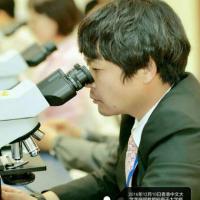| 图片: | |
|---|---|
| 名称: | |
| 描述: | |
- 20100712-什么类型肾肿瘤
-
本帖最后由 于 2010-07-13 21:38:00 编辑
| 以下是引用海上明月在2010-7-13 14:54:00的发言:
Arch Pathol Lab Med. 2010 Jan;134(1):124-9. Xp11.2 translocation renal cell carcinoma.Department of Pathology, University of Pittsburgh Medical Center, Pittsburgh, Pennsylvania 15213, USA. armahh2@upmc.edu |
名称:图1
描述:图1
名称:图2
描述:图2
名称:图3
描述:图3
名称:图4
描述:图4
名称:图5
描述:图5
名称:图6
描述:图6
名称:图7
描述:图7
名称:图8
描述:图8
名称:图9
描述:图9
名称:图10
描述:图10
名称:图11
描述:图11
名称:图12
描述:图12
名称:图13
描述:图13
名称:图14
描述:图14
名称:图15
描述:图15
名称:图16
描述:图16
名称:图17
描述:图17
名称:图18
描述:图18
名称:图19
描述:图19
名称:图20
描述:图20
名称:图21
描述:图21
-
本帖最后由 于 2010-07-13 14:56:00 编辑
Arch Pathol Lab Med. 2010 Jan;134(1):124-9.
Xp11.2 translocation renal cell carcinoma.
Department of Pathology, University of Pittsburgh Medical Center, Pittsburgh, Pennsylvania 15213, USA. armahh2@upmc.edu
Abstract
Xp11.2 translocation renal cell carcinomas (RCCs), a recently recognized distinct subtype, are rare tumors predominantly reported in young patients. They comprise at least one-third of pediatric RCCs, and only few adult cases have been reported. They are characterized by various translocations involving chromosome Xp11.2, all resulting in gene fusions involving the transcription factor E3 (TFE3) gene. In recent years, at least 6 different Xp11.2 translocation RCCs have been identified and characterized at the molecular level. These include a distinctive RCC that bears a translocation with the identical chromosomal breakpoints (Xp11.2, 17q25) and identical resulting ASPL-TFE3 gene fusion as alveolar soft part sarcoma. They typically have papillary or nested architecture and are composed of cells with voluminous, clear, or eosinophilic cytoplasm. Their most distinctive immunohistochemical feature is nuclear labeling for TFE3 protein. Although only limited data are available so far, they are believed to be rather indolent, but there have been increasing, recent reports of an aggressive clinical course in adult cases. The consistent immunohistochemical staining for TFE3 in all RCC with unusual histology, regardless of patient age, is likely to expand the spectrum of Xp11.2 translocation RCC with respect to age, clinical behavior, and molecular abnormalities

- 王军臣
此文是美国报道的一组病例,其发病年龄范围在22岁-78岁。
Am J Surg Pathol. 2007 Aug;31(8):1149-60.
Xp11 translocation renal cell carcinoma in adults: expanded clinical, pathologic, and genetic spectrum.
Argani P, Olgac S, Tickoo SK, Goldfischer M, Moch H, Chan DY, Eble JN, Bonsib SM, Jimeno M, Lloreta J, Billis A, Hicks J, De Marzo AM, Reuter VE, Ladanyi M.
The recently recognized Xp11 translocation renal cell carcinomas (RCCs), all of which bear gene fusions involving the TFE3 transcription factor gene, comprise at least one-third of pediatric RCC. Only rare adult cases have been reported, without detailed pathologic analysis. We identified and analyzed 28 Xp11 translocation RCC in patients over the age of 20 years. All cases were confirmed by TFE3 immunohistochemistry, a sensitive and specific marker of neoplasms with TFE3 gene fusions, which can be applied to archival material. Three cases were also confirmed genetically. Patients ranged from ages 22 to 78 years, with a strong female predominance (F:M=22:6). These cancers tended to present at advanced stage; 14 of 28 presented at stage 4, whereas lymph nodes were involved by metastatic carcinoma in 11 of 13 cases in which they were resected. Previously not described and distinctive clinical presentations included dense tumor calcifications such that the tumor mimicked renal lithiasis, and obstruction of the renal pelvis promoting extensive obscuring xanthogranulomatous pyelonephritis. Previously unreported morphologic variants included tumor giant cells, fascicles of spindle cells, and a biphasic appearance that simulated the RCC characterized by a t(6;11)(p21;q12) chromosome translocation. One case harbored a novel variant translocation, t(X;3)(p11;q23). Five of 6 patients with 1 or more years of follow-up developed hematogenous metastases, with 2 dying within 1 year of diagnosis. Xp11 translocation RCC can occur in adults, and may be aggressive cancers that require morphologic distinction from clear cell and papillary RCC. Although they may be uncommon on a percentage basis, given the vast predominance of RCC in adults compared with children, adult Xp11 translocation RCC may well outnumber their pediatric counterparts.

- 王军臣
下文显示该肿瘤发病年龄范围在15-59岁
Clin Cancer Res. 2009 Feb 15;15(4):1170-6.
Adult Xp11 translocation renal cell carcinoma diagnosed by cytogenetics and immunohistochemistry.
Komai Y, Fujiwara M, Fujii Y, Mukai H, Yonese J, Kawakami S, Yamamoto S, Migita T, Ishikawa Y, Kurata M, Nakamura T, Fukui I.
PURPOSE: To determine the incidence of Xp11 translocation renal cell carcinoma (RCC) in adult patients using cytogenetics and immunohistochemstry. EXPERIMENTAL DESIGN: Cytogenetic studies were prospectively done using tumor samples from 443 consecutive adult Japanese patients (ages 15-89 years) who underwent nephrectomy for RCC. TFE3 immunohistochemistry was done for cases in which cytogenetic results were not obtained. Clinicopathologic characteristics of Xp11 translocation RCC were examined. RESULTS: Mitotic cells suitable for cytogenetic analysis were obtained in 244 tumor samples (55%); among these, we identified 4 cases (1.6%) of Xp11 translocation RCC. TFE3 immunohistochemistry identified 3 positive cases (1.5%) among the remaining 199 cases. The median age of the 7 patients was 41 years (range, 15-59 years), and 15% of RCC patients (4 of 26) who were younger than ages 45 years had this type of RCC. Of the four Xp11 translocation RCC patients whose karyotypes were determined, two had an ASPL-TFE3 gene fusion. Of these 2, 1 had pulmonary metastasis at presentation, and the other developed liver metastasis 12 months after nephrectomy and died of the disease. The remaining two patients had PRCC-TFE3 and PSF-TFE3 gene fusions, respectively. Both had nodal involvement but remained disease free for 3 and 5 years, respectively, after surgical resection of lymph node metastases. Of the 3 immunohistochemically diagnosed patients, 1 had nodal metastases at presentation and died 9 months after surgery. CONCLUSIONS: This is the first report to determine the incidence of Xp11 translocation RCC in adult patients. We found that this disease is relatively common in young adults.

- 王军臣
-
本帖最后由 于 2010-07-13 14:48:00 编辑
请见下列报道
Am J Clin Pathol. 2007 Jul;128(1):70-9.
Xp11.2 translocation renal cell carcinoma with very aggressive course in five adults.
Meyer PN, Clark JI, Flanigan RC, Picken MM.
Renal cell carcinomas associated with Xp11.2 translocations ( TFE3 gene fusions) are rare tumors predominantly reported in children. We studied 5 cases of translocation carcinoma in adult patients, 18 years or older (mean age, 32.6 years). Tumors were examined histologically, immunohistochemically, and electron microscopically and correlated with the clinical picture. Most tumors showed solid sheets of clear to eosinophilic cells with rich vasculature and foci of papillary or pseudopapillary architecture. All cases showed strong nuclear positivity for TFE3. Vimentin and CD10 were positive in the cytoplasm. A panel of cytokeratin antibodies, smooth muscle actin, CD45, HMB45, and calretinin were negative. Patients had nonspecific initial complaints and were diagnosed with advanced disease, most with distant metastases. Various treatments met with minimal success. Unlike pediatric patients, the adult patients followed a rapidly terminal course, with a mean survival of 18 months after diagnosis (range, 10-24 months).

- 王军臣






















